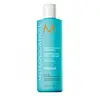What's inside
What's inside
 Key Ingredients
Key Ingredients

 Benefits
Benefits

 Concerns
Concerns

 Ingredients Side-by-side
Ingredients Side-by-side

Aloe Barbadensis Leaf Juice
Skin ConditioningSodium Laurylglucosides Hydroxypropylsulfonate
CleansingDisodium Laureth Sulfosuccinate
CleansingCocamidopropyl Hydroxysultaine
CleansingStearyldimoniumhydroxypropyl Laurylglucosides Chloride
CleansingDisodium Cocoamphodiacetate
CleansingGuar Hydroxypropyltrimonium Chloride
Skin ConditioningOryza Sativa Bran Extract
Skin ConditioningRosmarinus Officinalis Leaf Oil
MaskingHelianthus Annuus Seed Extract
Skin ConditioningTocopherol
AntioxidantFoeniculum Vulgare Oil
EmollientCymbopogon Schoenanthus Oil
MaskingCitrus Aurantifolia Oil
CleansingCaprylhydroxamic Acid
Caprylyl Glycol
EmollientGlycerin
HumectantCitric Acid
BufferingAloe Barbadensis Leaf Juice, Sodium Laurylglucosides Hydroxypropylsulfonate, Disodium Laureth Sulfosuccinate, Cocamidopropyl Hydroxysultaine, Stearyldimoniumhydroxypropyl Laurylglucosides Chloride, Disodium Cocoamphodiacetate, Guar Hydroxypropyltrimonium Chloride, Oryza Sativa Bran Extract, Rosmarinus Officinalis Leaf Oil, Helianthus Annuus Seed Extract, Tocopherol, Foeniculum Vulgare Oil, Cymbopogon Schoenanthus Oil, Citrus Aurantifolia Oil, Caprylhydroxamic Acid, Caprylyl Glycol, Glycerin, Citric Acid
Water
Skin ConditioningSodium Lauroyl Sarcosinate
CleansingCocamidopropyl Hydroxysultaine
CleansingCocamidopropyl Betaine
CleansingGlycerin
HumectantCocamide Dipa
EmulsifyingPolyquaternium-70
PEG-150 Pentaerythrityl Tetrastearate
EmulsifyingArgania Spinosa Kernel Oil
EmollientTilia Tomentosa Bud Extract
Skin ConditioningChondrus Crispus Extract
Skin ConditioningAscophyllum Nodosum Extract
Skin ConditioningLaminaria Saccharina Extract
Skin ProtectingPalmaria Palmata Extract
Skin ProtectingUndaria Pinnatifida Extract
Skin ConditioningCitric Acid
BufferingTocopherol
AntioxidantRetinyl Palmitate
Skin ConditioningGlycol Distearate
EmollientPEG-6 Caprylic/Capric Glycerides
EmulsifyingDiethylhexyl Syringylidenemalonate
Skin ProtectingCaprylic/Capric Triglyceride
MaskingLaureth-10
EmulsifyingCocamide Mea
EmulsifyingPolysorbate 20
EmulsifyingPEG-20 Glyceryl Laurate
EmulsifyingAcrylates/Palmeth-25 Acrylate Copolymer
Linoleic Acid
CleansingParfum
MaskingDipropylene Glycol
HumectantButylene Glycol
HumectantCaprylyl Glycol
EmollientTetrasodium EDTA
Chlorphenesin
AntimicrobialPhenoxyethanol
PreservativePotassium Sorbate
PreservativeSodium Benzoate
MaskingWater, Sodium Lauroyl Sarcosinate, Cocamidopropyl Hydroxysultaine, Cocamidopropyl Betaine, Glycerin, Cocamide Dipa, Polyquaternium-70, PEG-150 Pentaerythrityl Tetrastearate, Argania Spinosa Kernel Oil, Tilia Tomentosa Bud Extract, Chondrus Crispus Extract, Ascophyllum Nodosum Extract, Laminaria Saccharina Extract, Palmaria Palmata Extract, Undaria Pinnatifida Extract, Citric Acid, Tocopherol, Retinyl Palmitate, Glycol Distearate, PEG-6 Caprylic/Capric Glycerides, Diethylhexyl Syringylidenemalonate, Caprylic/Capric Triglyceride, Laureth-10, Cocamide Mea, Polysorbate 20, PEG-20 Glyceryl Laurate, Acrylates/Palmeth-25 Acrylate Copolymer, Linoleic Acid, Parfum, Dipropylene Glycol, Butylene Glycol, Caprylyl Glycol, Tetrasodium EDTA, Chlorphenesin, Phenoxyethanol, Potassium Sorbate, Sodium Benzoate
 Reviews
Reviews

Alternatives
Ingredients Explained
These ingredients are found in both products.
Ingredients higher up in an ingredient list are typically present in a larger amount.
Caprylyl Glycol is a humectant and emollient, meaning it attracts and preserves moisture.
It is a common ingredient in many products, especially those designed to hydrate skin. The primary benefits are retaining moisture, skin softening, and promoting a healthy skin barrier.
Though Caprylyl Glycol is an alcohol derived from fatty acids, it is not the kind that can dry out skin.
This ingredient is also used as a preservative to extend the life of products. It has slight antimicrobial properties.
Learn more about Caprylyl GlycolCitric Acid is an alpha hydroxy acid (AHA) naturally found in citrus fruits like oranges, lemons, and limes.
Like other AHAs, citric acid can exfoliate skin by breaking down the bonds that hold dead skin cells together. This helps reveal smoother and brighter skin underneath.
However, this exfoliating effect only happens at high concentrations (20%) which can be hard to find in cosmetic products.
Due to this, citric acid is usually included in small amounts as a pH adjuster. This helps keep products slightly more acidic and compatible with skin's natural pH.
In skincare formulas, citric acid can:
While it can provide some skin benefits, research shows lactic acid and glycolic acid are generally more effective and less irritating exfoliants.
Most citric acid used in skincare today is made by fermenting sugars (usually from molasses). This synthetic version is identical to the natural citrus form but easier to stabilize and use in formulations.
Read more about some other popular AHA's here:
Learn more about Citric AcidCocamidopropyl Hydroxysultaine is a synthetic cleansing agent, though it is derived from coconut oil.
It is used to enhance the texture of products by boosting lather and thickening the texture. As a cleanser, Cocamidopropyl Hydroxysultaine is mild.
Glycerin is already naturally found in your skin. It helps moisturize and protect your skin.
A study from 2016 found glycerin to be more effective as a humectant than AHAs and hyaluronic acid.
As a humectant, it helps the skin stay hydrated by pulling moisture to your skin. The low molecular weight of glycerin allows it to pull moisture into the deeper layers of your skin.
Hydrated skin improves your skin barrier; Your skin barrier helps protect against irritants and bacteria.
Glycerin has also been found to have antimicrobial and antiviral properties. Due to these properties, glycerin is often used in wound and burn treatments.
In cosmetics, glycerin is usually derived from plants such as soybean or palm. However, it can also be sourced from animals, such as tallow or animal fat.
This ingredient is organic, colorless, odorless, and non-toxic.
Glycerin is the name for this ingredient in American English. British English uses Glycerol/Glycerine.
Learn more about GlycerinTocopherol (also known as Vitamin E) is a common antioxidant used to help protect the skin from free-radicals and strengthen the skin barrier. It's also fat soluble - this means our skin is great at absorbing it.
Vitamin E also helps keep your natural skin lipids healthy. Your lipid skin barrier naturally consists of lipids, ceramides, and fatty acids. Vitamin E offers extra protection for your skin’s lipid barrier, keeping your skin healthy and nourished.
Another benefit is a bit of UV protection. Vitamin E helps reduce the damage caused by UVB rays. (It should not replace your sunscreen). Combining it with Vitamin C can decrease sunburned cells and hyperpigmentation after UV exposure.
You might have noticed Vitamin E + C often paired together. This is because it is great at stabilizing Vitamin C. Using the two together helps increase the effectiveness of both ingredients.
There are often claims that Vitamin E can reduce/prevent scarring, but these claims haven't been confirmed by scientific research.
Learn more about Tocopherol